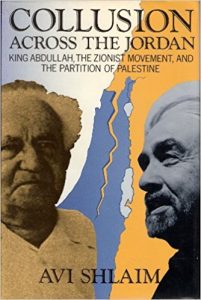Collusion Across The Jordan
King Abdullah, The Zionist Movement And The Partition Of Palestine
Reviewed by John C. Campbell, Foreign Affairs, (capsule reviews), Spring 1989 (Columbia University Press, 676 pps.)
“This massive volume puts a burden on the reader, but it is a welcome burden because its very wealth of detail brightens the light thrown on relations among the three key actors in the drama of the partition of Palestine (Britain, Jordan and the Zionists). Access to recently opened archives in London, Washington and Israel, plus revealing interviews and the use of memoirs and other material on both the Israeli and the Arab side, enabled the author not only to fill in the gaps in the known story but also to change it in significant respects. He may overstress the point that his is “revisionist” history, but it does differ from many existing Zionist as well as pro-Arab accounts and, as the record he adduces shows, with good reason. The book should certainly stand the test of time.”
Reviewed by Ronald Sanders, The New York Times, reviewed jointly with the Birth of the Palestinian Refugee Problem, under the title Letting the record speak, 1988
” IF revisionist history means a kind of writing that differs, on grounds of scholarly objectivity, from popular assumptions and myths, then all serious historical writing is revisionist. Even as one puzzles at King Hussein’s recent severing of Jordan’s legal and administrative ties to the West Bank and the proposals of the Palestine Liberation Organization to assume political responsibility there, it is useful to know the historical background so brilliantly presented in two new books by Israeli historians. Both re-examine aspects of their country’s origins as a state and are not afraid to be tough toward their own when truth requires that they be so.”
“Indeed, Avi Shlaim, a fellow of St. Antony’s College at Oxford, is tough toward the Israelis even when he does not have to be. His ”Collusion Across the Jordan” – which is largely based on hitherto unavailable source materials – is a lucid and meticulous study of the 30-year political relationship between the Zionist (later Israeli) leadership on one side of the River Jordan and the Emir (later King) Abdullah on the other, ending only with the assassination of the latter by a Palestinian nationalist in 1951. This strange and mostly clandestine, yet crucial, relationship stands now as a demonstration that even in 1948, when the new state of Israel was being invaded by Arab armies on all sides, the lineup against it was not really so monolithic as it seemed.”…
“It is with regard to the question of the West Bank that Mr. Shlaim’s book is particularly instructive. For the fact emerges quite clearly that the 1949 armistice border between Israel and Jordan – and, above all, the line that cut Jerusalem in two – was not so purely an accident of war as may once have seemed to be the case. Rather, it was to some extent the product of understandings (albeit strained at times) between Abdullah and the Israelis. Mr. Shlaim demonstrates that if Jerusalem in particular came to be divided between Jordan and Israel, it was largely because this was the arrangement preferred by both countries’ leaders to the internationalization of the city proposed by the United Nations in November 1947. If the fighting over Jerusalem and its access corridor became fierce in 1948, this was because the Israelis occasionally showed signs of wanting more than the Jordanians thought they should have. But throughout the war, as Mr. Shlaim shows, the Jordanians were scrupulous about not engaging Jewish troops in areas that had been designated as part of the proposed Jewish state in the November 1947 United Nations resolution.” (more…)

